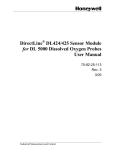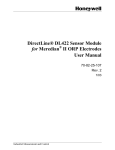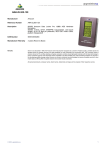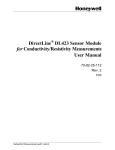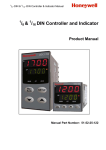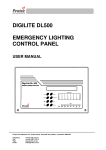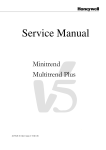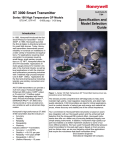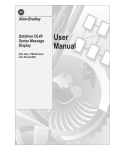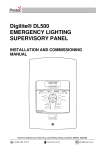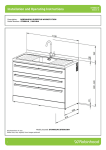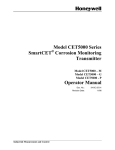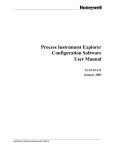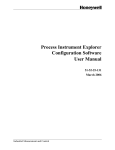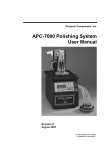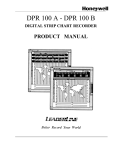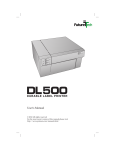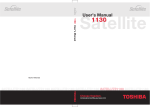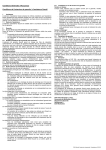Download Analytical Instruments: Honeywell DL5000 Dissolved Oxygen (D.O.
Transcript
DL5000 Dissolved Oxygen (D.O.) Probe User’s Manual 70-82-25-114 5/02 Industrial Process Control Notices and Trademarks Copyright 2002 by Honeywell May, 2002 Warranty/Remedy Honeywell warrants goods of its manufacture as being free of defective materials and faulty workmanship. Contact your local sales office for warranty information. If warranted goods are returned to Honeywell during the period of coverage, Honeywell will repair or replace without charge those items it finds defective. The foregoing is Buyer's sole remedy and is in lieu of all other warranties, expressed or implied, including those of merchantability and fitness for a particular purpose. Specifications may change without notice. The information we supply is believed to be accurate and reliable as of this printing. However, we assume no responsibility for its use. While we provide application assistance personally, through our literature and the Honeywell web site, it is up to the customer to determine the suitability of the product in the application. Industrial Process Control Honeywell 1100 Virginia Drive Fort Washington, PA 19034 DirectLine is a trademark of Honeywell Other brands or product names are trademarks of their respective owners ii DL500 Dissolved Oxygen (D.O.) Probe – User’s Manual 5/02 About This Document Abstract This manual provides description, specification, installation, mounting, maintenance and troubleshooting information for the Honeywell DL5000 Dissolved Oxygen (D.O.) Probe. Contacts World Wide Web The following lists Honeywell’s World Wide Web sites that will be of interest to our customers. Honeywell Organization WWW Address (URL) Corporate http://www.honeywell.com Industrial Process Control http://www.honeywell.com/ipc Telephone Contact us by telephone at the numbers listed below. United States and Canada Organization Phone Number Honeywell 1-800-423-9883 Tech. Support 1-888-423-9883 Q&A Faxback (TACFACS) 1-800-525-7439 Service Symbol Definitions The following table lists any symbols used in this document to denote certain conditions. Symbol Definition Earth Ground. Functional earth connection. NOTE: This connection shall be bonded to Protective earth at the source of supply in accordance with national and local electrical code requirements. 5/02 DL5000 Dissolved Oxygen (D.O.) Probe – User’s Manual iii Contents 1. INTRODUCTION ................................................................................................... 1 1.1 Overview ........................................................................................................................1 1.2 Probe Description...........................................................................................................1 1.3 Operating Principal.........................................................................................................1 2. SPECIFICATIONS AND MODEL SELECTION GUIDE ........................................ 2 2.1 Specifications.................................................................................................................2 2.2 Model Selection Guide ...................................................................................................3 3. INSTALLATION .................................................................................................... 4 3.1 Mounting and Wiring ......................................................................................................4 DL424/425 Integral Mounting............................................................................................4 DL424/425 Remote Mounting ...........................................................................................5 Series 7020 Remote Mounting and Wiring........................................................................7 Probe System Check ........................................................................................................8 System Check for Probe with Model 7020 ........................................................................8 3.2 Probe Mountings ............................................................................................................9 Wastewater Submersion...................................................................................................9 In-line Flow Mounting......................................................................................................10 Flow Through Mounting ..................................................................................................10 Mounting Recommendation for Easy Calibration in Boiler Control Loop .........................12 4. MAINTENANCE .................................................................................................. 13 4.1 Introduction ..................................................................................................................13 Inert Fouling: ..................................................................................................................13 Biologically Active Slime: ................................................................................................13 4.2 To Clean ......................................................................................................................14 4.3 O-Ring Replacement....................................................................................................14 4.4 Probe Storage..............................................................................................................14 Short term.......................................................................................................................14 Long term .......................................................................................................................14 4.5 Packing Probe for Shipment or Storage .......................................................................14 5. TROUBLESHOOTING ........................................................................................ 15 5.1 Diagnostic Error Messages DL424/425 ........................................................................15 5.2 Troubleshooting 7020 Analyzer ....................................................................................17 5.3 Processes Containing Carbon Dioxide .........................................................................17 5.4 Leak Detection in PPB Applications .............................................................................18 iv DL500 Dissolved Oxygen (D.O.) Probe – User’s Manual 5/02 Tables Table 3-1 Integral Mounting Procedure ( Figure 3-1)____________________________________ 4 Table 3-2 Remote Mounting and Wiring Procedure for DL5000 Probes____________________ 5 Table 5-1 Online Diagnostic Errors __________________________________________________ 15 Figures Figure 3-1 Integral Mounting ____________________________________________________ 4 Figure 3-2 Remote Wiring ______________________________________________________ 6 Figure 3-3 Connect/Disconnect Sequence for the Series 7020 D.O. Analyzer ______________ 7 Figure 3-4 Waste Water Mounting ________________________________________________ 9 Figure 3-5 In-Line Mounting Kit _________________________________________________ 10 Figure 3-6 Flow Through Mounting ______________________________________________ 11 Figure 3-7 Mounting Recommendation for Easy Calibration in Boiler Control Loop _________ 12 5/02 DL5000 Dissolved Oxygen (D.O.) Probe – User’s Manual v vi DL500 Dissolved Oxygen (D.O.) Probe – User’s Manual 5/02 Introduction 1. Introduction 1.1 Overview This document provides description, specification, installation, mounting, maintenance, and trouble shooting information for the Honeywell DL5000 Dissolved Oxygen (D.O.) probe. This probe can be used with the DL424, DL425, or the 7020 Series Dissolved Oxygen analyzers. 1.2 Probe Description The Honeywell probe is housed in either PVC or Stainless steel casing. One end has a 1” NPT male thread for mounting. The sensor extends from the housing and is covered by a protective guard (of the same material as the casing) which allows sample entry while preventing physical damage. The probe has permanent electrolyte which is sealed at the rear with an expansion chamber to compensate for pressure changes. The sensor assembly is permanently potted into the housing and is not field replaceable. Operational service in wastewater applications should consist of an occasional wash to remove any large deposits at the sensor end. This can usually be accomplished without removing the protective guard. If the protective guard is removed, additional care must be taken to minimize the chance of puncturing a hole in the probe membrane. See Probe Maintenance section for proper cleaning procedures. Physically the probe consists of three electrodes and a thermistor for temperature measurement and compensation. Two electrodes are interspaced on a supporting substrate and covered with an electrolyte; these electrodes are connected as anode and cathode. The third or reference electrode is mounted in the center of the electrode support and is also in contact with the electrolyte. The anode and cathode perform the oxygen generation and reduction functions while the reference electrode maintains the correct electrochemical potential. 1.3 Operating Principal When the probe is placed into the sample stream, oxygen diffuses through the membrane and is reduced at the cathode, and an equal amount of oxygen is generated at the anode. The diffusion continues until the oxygen partial pressure on both sides of the membrane is equal and a balance exists. The electrical circuit is designed such that the current necessary to maintain this equilibrium is converted to read out the dissolved oxygen concentration in the solution. The reactions are as follows: At cathode: O2 + 4H+ + 4 e- ® 2H2O At anode: 2H2O ® O2 + 4H+ + 4 eResult: No net reaction 5/02 DL5000 Dissolved Oxygen (D.O.) Probe – User’s Manual 1 Specifications 2. Specifications and Model Selection Guide 2.1 Specifications Normal Operating Temperature Range: 2 – 60 °C (35.6 – 140°F) Storage Temperature: 2 – 60 °C (35.6 – 140°F) (See Attention) Maximum Flow Rate: No dependence on stirring or flow. However, a minimal flow of 100 ml/min is expected to provide a “flowing” sample. for flow through mounting: 300 ml/min for in-line mounting: 5 gal/min (18.9 liter/min) in a 1” Schedule 40 Line for submersion mounting: Not applicable Maximum Pressure: 30 psi (207 kPa) for PVC probe 50 psi (345 kPa) for SS probe Response time: 90% in 60 seconds (after Probe Warm-up) Probe Accuracy in parts per billion (ppb) measurements: ±5% or 2 ppb whichever is greater at calibration conditions, after stabilization in parts per million (ppm) measurements: ±0.2 ppm at calibration conditions, after stabilization Probe Materials of Construction: PVC or Stainless Steel with a 20 ft. (6.1m) waterproof cable. The PVC model is also available with a 100 ft.(30.48m) waterproof cable. Probe Dimensions (same for PVC & SS): Probe Weight: 8 .62” long X 1.315” OD (219 X 34 mm) PVC 1.24 lb (0.6 kg) SS: 3.5 lb (1.5 kg) ATTENTION Probe membrane must be kept wetted both in the process and during storage. See Storage under Maintenance section. The silicone membrane surrounding the D.O. probe is permanent. If this membrane is removed by user for any reason, the warranty on the D.O. probe is voided 2 DL500 Dissolved Oxygen (D.O.) Probe – User’s Manual 5/02 Specifications 2.2 Model Selection Guide Instructions Select the desired key number. The arrow to the right marks the selection available. Make one selection from Tables I & II using the column below the proper arrow. A dot ( ) denotes unrestricted availability. Key Number ______ - I ___ II ____ - KEY NUMBER DESCRIPTION DL5000 Dissolved Oxygen Probe - Parts Per Billion Selection DL5PPB DL5000 Dissolved Oxygen Probe - Parts Per Million DL5PPM TABLE I - Probe Construction: Material of Construction Mounting PVC PVC None 300 400 Remote PVC 100 200 20' Remote 316 Stainless Steel PPB PPM Cable Length Integral 316 Stainless Steel Availability 100' 700 TABLE II - Options Tagging None 00_ _ Linen Customer I.D. Tag: 3 lines w/22 characters/line Stainless Steel Customer I.D. Tag 3 lines w/22 characters/line LN_ _ Standard Warranty Extended Warranty Against Manufacturing Defects 5/02 1 Year Extended Warranty 2 Years Extended Warranty SS_ _ _ _00 _ _W2 _ _W3 DL5000 Dissolved Oxygen (D.O.) Probe – User’s Manual 3 Installation 3. Installation 3.1 Mounting and Wiring The following section describes the installation of the Honeywell D. O. probe. DL424/425 Integral Mounting Table 3-1 Integral Mounting Procedure ( Figure 3-1) Step Procedure 1 Connect the probe to the process source (using the appropriate mounting from those supplied for the DL5000). Make sure that the final position of the installed electronics module allows the display to be easily viewed by personnel. 2 Apply a thin film of silicon grease on the ID of the electronics module’s probe mounting cavity. 3 Align the slots on the electronics module with those on the probe and press down to connect the electronics to the probe. 4 Tighten the locking screw on the bottom rear of the electronics module. Electronics Module Locking Screw in Rear of Housing Step 2 Step 3 Step 4 Probe Step 1 Figure 3-1 Integral Mounting 4 DL500 Dissolved Oxygen (D.O.) Probe – User’s Manual 5/02 Installation DL424/425 Remote Mounting When the DL424 or DL425 module is specified with Table II = 6, a remote connector assembly (part number 51500768-005) is supplied loose. The remote cable connector is used to connect the DL5000 probe cable to the DL424/425 module. Table 3-2 gives the mounting procedure. Table 3-2 Remote Mounting and Wiring Procedure for DL5000 Probes Step Procedure (Refer to Figure 3-2 ) 1 Turning counterclockwise, remove strain relief/cover combination from the remote connector assembly. 2 Remove the protective plastic bag from the end of the probe cable. Be careful to keep bare fingers away from coax cable termination. 3 Loosen and remove compression cap from strain relief fitting. Carefully push cable end through cap and strain relief fitting so that these parts are strung back along cable jacket. 4 Connect cable leads as follows: See Figure 3-2. Terminal 1 = Pigtail Shield Lead (Black/White) Terminal 2 = Temperature Compensation Lead (Orange) Terminal 3 = Temperature Compensation Lead (Yellow) Terminal 4 = Anode (Red) Terminal 5 = Reference (Green) Terminal 6 = Cathode Silver Pin (Coax) Earth Ground = Blue 5/02 5 Slide cover along cable and tighten by hand onto the remote connector assembly. 6 Slide cap along cable and tighten onto cable jacket with small wrench until cable cannot slide within strain relief rubber bushing. 7 Remove red protective vinyl boot from opposite end of connector assembly. 8 Apply a thin film of silicon grease to the ID of electronics module’s remote mounting cavity. 9 Plug remote connector assembly into DL424/425 module aligning polarity tab of module housing and mating groove on connector. DL5000 Dissolved Oxygen (D.O.) Probe – User’s Manual 5 Installation DL5000 Probe Electronics Electronics Module M O D E 1 2 1 2 3 4 5 6 Protective Vinyl Boot (remove) Pigtail Shield (Black/White) Temperature Compensation (Orange) Temperature Compensation (Yellow) Anode (Red) Reference (Green) Cathode Silver Pin (Coax) Earth Ground (Blue) 6 5 4 1 2 3 Cover Strain Relief Compression Cap Remote Wiring Cable Probe Remote Electronics for Module DL5000 Dissolved Oxygen Probes Figure 3-2 Remote Wiring 6 DL500 Dissolved Oxygen (D.O.) Probe – User’s Manual 5/02 Installation Series 7020 Remote Mounting and Wiring When connecting the probe to the Series 7020 Analyzer, the probe wiring should always be kept separated from the AC power wiring. After the analyzer and probe have been securely mounted, the probe should be connected to the analyzer. Before wiring, remove the protective insulator tape from the green lead. To make wiring easier on the 7020 Series analyzer, loosen the screw at the bottom of the terminal board and remove the terminal block from the panel while wiring. Figure 3-3 gives the sequence for connecting and disconnecting the probe from the 7020 Series analyzer. CAUTION When installing the probe the wiring must be done in the order shown in Figure 3-3, even if the analyzer is not powered. This is because the battery backup card is continuously supplying a voltage (bias) to the terminals. Connecting – Shield wire first, then in this order Red Green Coax Yellow Orange Disconnecting – Go in reverse Orange - first Yellow Coax Green Red Shield Wire TB5 33 ANODE (Red) REF (Green) CATH SILVER PIN (Coax) THERM+ (Yellow) THERM – (Orange) SHIELD (White/Black) ALL+ ALL – 40 Figure 3-3 Connect/Disconnect Sequence for the Series 7020 D.O. Analyzer 5/02 DL5000 Dissolved Oxygen (D.O.) Probe – User’s Manual 7 Installation Probe System Check When the probe is connected for the first time, replaced or just disconnected and reconnected, a conditioning period of 24 hours is needed before the probe can make an accurate measurement. During this time period, the probe must be kept wetted by either putting it in the process water or in a container of water exposed to air. For ppb applications, it is recommended that process conditions are used. Once the 24 hour period has elapsed, the probe can be calibrated. The calibration instructions are as follows: 1. Remove probe from either the process or container of water and put in ambient air. If probe was in process wastewater, clean probe first per cleaning instructions under the maintenance section. If the probe is in a ppb process, expose the probe to air for 2 - 4 hours before doing an Air calibration. 2. Perform an Air calibration or Sample calibration. Make sure probe temperature is stable before performing an Air calibration. If temperature is not stable, the Air calibration will fail. ATTENTION Do not perform an Air calibration on a windy day or during freezing temperatures. The temperature will not stabilize on a windy day and freezing temperatures will cause the probe’s electrolyte to freeze and the membrane to crack. 3. At completion of a successful air or sample calibration, put probe into process water. After the initial calibration, the probe should only be removed from the process for periodic cleaning and calibration. The recommended cleaning schedule for ppb applications is monthly and for ppm applications it is bimonthly. If the probe’s response has slowed or readings are lower than expected prior to the recommended cleaning schedule, the probe may need to be cleaned more frequently. The recommended calibration schedule for ppb and ppm applications is monthly. If individual plant maintenance schedules require it, the probe may be calibrated more frequently. System Check for Probe with Model 7020 Perform a system check upon completion of all wiring. AC noise in the various analyzer output connections may affect the bias amplifier resulting in a DC current in the reference lead. This DC current will cause dissolution on the silver reference electrode over time resulting in a shortened probe life. See Appendix A in the 7020 Operator manual for directions on Noise testing. 8 DL500 Dissolved Oxygen (D.O.) Probe – User’s Manual 5/02 Installation 3.2 Probe Mountings Wastewater Submersion Various mounting are available for the Honeywell D.O. probe. Figure 3-4 shows the probe mounting kit for Wastewater Submersion. Except for the 1” schedule 40 PVC pipe or conduit, this kit contains all pieces needed to mount the probe to 1-1/2” diameter safety railings. The length of the pipe or conduit governs the depth of the probe immersion while the angle piece governs the horizontal distance. To minimize debris build-up, place the probe into the process at a 45 ° angle from the horizontal pipe railing. The cable can be routed though the supporting pipe or tied to its side. If the kit is not used and plastic pipe is preferred, use 1” to 1 ½” coupling. The use of the pipe is suggested to avoid whipping of the pipe when used in flowing or turbulent water. D.O. Receiver Pin Fitting (2 req’d) 31063325 (Note location of pins Wrench 31063326 Clamp on Tee (2 req’d) 31063327 1” Pipe Size Eye Fitting (2 req’d) 31063329 1 1/2” Pipe Size 24” to 30” Long 1 1/2” Pipe Size 6” to 8” Long Single Socket Tee 31063328 1” X 1” Female Coupling 31063330 D.O. Probe Assembly Figure 3-4 Waste Water Mounting 5/02 DL5000 Dissolved Oxygen (D.O.) Probe – User’s Manual 9 Installation In-line Flow Mounting In applications where the probe goes directly into the process pipeline, the in-line flow mounting is available. This mounting is diagramed in Figure 3-5. 30669860-017 O-ring 3/4” NPT (REF) Customer Installation Kit # 51452226-001 (SST) 51452226-002 (PVC) Figure 3-5 In-Line Mounting Kit Flow Through Mounting In most low ppb applications, the Pure Water Flow Through mounting is recommended. This assembly is usually pipe clamp mounted close to the sampling port. A single 1” pipe clamp is normally all that is needed for physical mounting. Inlet and outlet fittings are designed to mate to ¼” O.D. tubing. ATTENTION When assembling the flow through kit, extreme caution must be used when installing or removing the probe flow assembly from the probe. The assembly threads can cut the membrane if they contact it (especially the stainless steel assemblies). In ppb applications, the integrity of the sample lines feeding the ppb probe is of extreme importance. Since the oxygen level in air is usually three orders of magnitude greater than the sample level, oxygen can leak into the sample lines without any indication of liquid leaking out, resulting in erroneous readings. To reduce risk of leaks, use a minimum number of fittings in the sample lines and make sure each fitting is tightened. The sample should be discharged to Atmospheric pressure (open drain). 10 DL500 Dissolved Oxygen (D.O.) Probe – User’s Manual 5/02 Installation The flow through mounting is diagramed in Figure 3-6. 1 5/16” Kits 51452187-001 Stainless Steel 51452187-002 PVC Outlet Male Compression Fitting for 1/4 O.D. Tubing 9 1/2” Dissolved Oxygen Probe Replacement O-ring 30669860-017 Flow Through Adapter Male Compression Fitting for 1/4 O.D. Tubing Inlet Figure 3-6 Flow Through Mounting 5/02 DL5000 Dissolved Oxygen (D.O.) Probe – User’s Manual 11 Installation Mounting Recommendation for Easy Calibration in Boiler Control Loop A "Trap" arrangement should be plumbed in the incoming flow to the DO probe so that if flow is shut off or an "Upstream" pipe opened, water will remain around the tip of the probe. Keeping it moist on the outlet side, an arrangement such as a "TEE" should be made to assure that when the 3-way valve is opened (for Air Calibration), the water within the probe flows out. "Cracking" the fittings on the inlet side will achieve the same result as a 3-way valve, but repeated "Cracking" will cause wear on the parts and any additional handling may shorten the life of the probe. AIR PROBE PRESS FLOW METER TEMP FLOW X DRAIN TRAP 3-WAY VALVE DRAIN Figure 3-7 Mounting Recommendation for Easy Calibration in Boiler Control Loop To avoid drying out the probe sensor when the sampling point is shut off, a water trap should be made in the inlet piping 12 DL500 Dissolved Oxygen (D.O.) Probe – User’s Manual 5/02 Maintenance 4. Maintenance 4.1 Introduction The Honeywell D. O. probe requires no internal probe maintenance. However, like all other probes, it does need to be cleaned periodically. After a long period of use, the oxygen transfer may cease due to a coating buildup. This buildup may consume or block the oxygen, increase the response time and / or reduce the probe accuracy. Cleaning the probe is easy and is normally accomplished by agitating the probe in a container of fluid. The cleaning fluid can vary from water to a 10% HCl solution depending on the type of buildup or fouling encountered. Inert Fouling: (ex. hair, grease, and solids) This type of fouling normally occurs in wastewater applications; however, rust-like contaminants may occur in ppb applications. When a significant amount of this debris is deposited on the probe, the response time of the probe slows down. Normal cleaning practices should restore probe to correct operation. Biologically Active Slime: This type of fouling consists of biologically active slime adhering either loosely or tightly to the probe or the protective cap or both. This slime can be visible or invisible and may produce a sticky feel to the probe and / or cap’s surface area. This type of fouling is usually characterized by the following performance: the signal drifts slowly downward for several hours (or days) and then drops precipitously toward zero in a matter of a few hours or less. Proper air calibration can be restored only after very careful wiping of the probe tip or a 30 second rinse in a 10% HCl solution. The time between cleanings can be extended by relocating the probe to a cleaner environment (nearer the effluent) or relocating the probe to where the water is flowing faster. After these actions are taken, a cleaning schedule should be established. ATTENTION Never use a brush to clean a Honeywell D.O. probe as it can cause a tear in the probe membrane rendering it inoperable. This type of abuse is not covered under probe warranty. 5/02 DL5000 Dissolved Oxygen (D.O.) Probe – User’s Manual 13 Maintenance 4.2 To Clean Cleaning should consist of the simplest of the following required to re-establish proper performance: 1.)Rinsing with water 2.) rinse with mild detergent followed by water 3.) rinse with 10% HCl followed by mild detergent followed by water. If the probe must be wiped, carefully use a paper towel or cotton swab. After cleaning is completed, place the probe back into the process and allow 60 minutes before a calibration. 4.3 O-Ring Replacement To replace the O-ring shown in Figure 3-6: 1. Place the o-ring over the threads of either the flow through or in-line fitting. 2. Silicone grease may be used to assist in O-ring installation. 3. Attach the adapter to the probe. Be careful not to touch the probe membrane. 4.4 Probe Storage Short term The Honeywell probe arrives from the factory with an red cap on the end of the probe. This cap contains a 3% solution of Isopropyl alcohol and water. The water keeps the probe wetted until it is put into the process. The alcohol minimizes the growth of bacteria. Long term If the probe remains on the shelf for longer than 6 months, the solution inside the cap must be replaced. To do this, remove the side mounted, threaded pipe plug using a 3/16 hex key wrench. Fill the hole with a fresh solution of 3% Isopropyl alcohol and water, and replace the hex screw. This procedure keeps the probe wetted and minimizes incidence of bacteria. 4.5 Packing Probe for Shipment or Storage When removing the probe from service for storage or shipment, replace the red cap that came with the probe. Fill the probe as described in Storage – Long term. This prevents damage caused by long-term contact with the other probe leads. 14 DL500 Dissolved Oxygen (D.O.) Probe – User’s Manual 5/02 Troubleshooting 5. Troubleshooting 5.1 Diagnostic Error Messages DL424/425 When a diagnostic error or status condition occurs, the Online Display alternates between measured DO and a text message. Table 5-1 Online Diagnostic Errors What you see CnFG FALt What it is What to do Configuration or Calibration data is defective. Reset unit or cycle power. Unit electronics are defective. Replace electronics module. Second occurrence will show FALt. These errors may occur when on-line DO Concentration or on-line Temperature is displayed. dOHI Measured DO is > 20 ppm/200 ppb Bring process to within limits dOLo Measured DO is < 0.00 ppm/ppb Bring process to within limits PrbE Probe is defective, wrong type, or not connected. Check for an electrical short between the anode and the cathode. Probe current is excessive with probe voltage near 0 volts. Forces the output to burnout level (greater than 22 mA). 5/02 Check the reference electrode connection. When the source of the error is removed, the error will clear and the output will return to normal operation. T HI Measured temperature is > 60 °C Bring process to within limits T LO Measured temperature is < 2.0 °C Bring process to within limits DL5000 Dissolved Oxygen (D.O.) Probe – User’s Manual 15 Troubleshooting What you see bErr What it is Probe Bias Error: Probe current has exceeded expected probe current by 33% for at least 20 seconds. If the excessive current condition continues after a manual probe bias , the PrbE error is generated. If excessive current is not present then the bErr remains. Application related shift in probe bias voltage What to do Remove the probe from process and do a probe bias calibration. In ppm applications in processes containing CO2, the probe may be left in the process and the Bias can be manually adjusted. Remove the probe from the process and do an Air Calibration These errors may occur during Air, Sample and Probe Bias calibration and abort the calibration process. FAIL These error messages are preceded by the message “FAIL” Press Mode to return to online display. ArnG Air Calibration failed due to a measured probe current not in the acceptable range Stbl Air Calibration failed due to input measurement instability bErr Bias voltage calibration failed due to unacceptable input current. Replace Probe. 16 DL500 Dissolved Oxygen (D.O.) Probe – User’s Manual 5/02 Troubleshooting 5.2 Troubleshooting 7020 Analyzer The Honeywell 7020 Series Operator manual contains many tips for trouble shooting the 7020 Series analyzer. Consult the Matrix of Potential Problems and Solutions under Section 5.2 in the Operator manual for information on your particular problem. In addition, the appendix section of the Honeywell 7020 Series Operator manual provides information on various subjects related to the D.O. probe, including the following topics: · Excess AC noise can result in a shorten probe life. To ensure that there is no excess noise on the probe leads, use the procedure in Appendix A in the 7020 manual – Noise Testing to test your probe installation. · If a D.O. reading doesn’t seem correct, check that the probe and analyzer are working correctly by using the procedures provided in Appendix B in the 7020 manual – Probe and Analyzer Tests. · To confirm the D.O. measurement in air at a specific temperature, consult Appendix E in the 7020 manual – Percent Saturation Readout to get the expected DO concentration in air or air saturated water at various temperatures. This information will confirm if the probe is giving a valid measurement in air. · If a leak is suspected in a ppb system, consult Appendix F in the 7020 manual – Leak Detection in PPB Applications to understand how to use the D.O. probe to find a leak. · Want proof that a D.O. probe can go down to zero ppbs? Consult Appendix G in the 7020 manual – Procedure for Low level ppb Dissolved Oxygen testing to confirm that your probe can get down to zero ppbs. 5.3 Processes Containing Carbon Dioxide When measuring D.O. in a process containing carbon dioxide (e.g. beer or soda) special procedures are required to protect the probe. To remove the probe from the line: 1. Shut off sample line containing CO2. 2. Purge the line containing the probe with fresh water at the same pressure for 15 minutes to remove the CO2 from the D. O. probe. 3. Remove probe when convenient. CAUTION Not following this procedure will cause internal rupture of the membrane rendering the probe inoperable, un-repairable and void of any probe warranty. For optimum performance in this application, the bias voltage should be adjusted to measure 450 mV instead 600 mV. Review the Series 7020 operator manuals for adjusting the Probe Bias. 5/02 DL5000 Dissolved Oxygen (D.O.) Probe – User’s Manual 17 Troubleshooting 5.4 Leak Detection in PPB Applications Before performing and air leak detection, it is necessary to determine that both the probe and analyzer are working properly. First, check to see that the probe contains an O-ring. Per the probe directions, an O-ring must go into a probe that is used in ppb applications. This creates a tight seal between the probe and flow chamber. MAKE SURE THIS O-RING IS IN THE PROBE. 1. Unless already in air, open the probe to air for 30 seconds. 2. Put it back into the process again. 3. Allow the DO to drift down to the 20-30 ppb range. The 20-30 ppb range was chosen because the reading was low enough that the drift was small with respect to the changes observed for various flow rates but high enough that changes could be observed. 4. At this range, vary the flow rate from 10 to 100 ml/min. These low flow rates were selected for two reasons. The first, the tester many only have a 0 - 100 ml/min flow indicator. The other reason, is a leak that exists at this low flow, will cause a change in the DO reading. 5. If the DO value at 10 ml/min exceeds the DO value at 100 ml/min, a leak is present in the sampling line. 6. Fixing the leak may require plastic tubing to be replaced with metal tubing, tape to be put on fittings, and/or fittings at the bottom of the probe to be tighten securely. 7. Now, repeat Steps 2 - 6 until the flow can be changed from >100 ml/min to 10 ml/min with no change in the DO value. 18 DL500 Dissolved Oxygen (D.O.) Probe – User’s Manual 5/02 Troubleshooting 5/02 DL5000 Dissolved Oxygen (D.O.) Probe – User’s Manual 19 Sales and Service For application assistance, current specifications, pricing, or name of the nearest Authorized Distributor, contact one of the offices below. ARGENTINA HONEYWELL S.A.I.C. BELGRANO 1156 BUENOS AIRES ARGENTINA Tel. : 54 1 383 9290 ASIA PACIFIC HONEYWELL ASIA PACIFIC Inc. Room 3213-3225 Sun Kung Kai Centre N° 30 Harbour Road WANCHAI HONG KONG Tel. : 852 829 82 98 AUSTRALIA HONEYWELL LIMITED 5 Thomas Holt Drive North Ryde Sydney NSW AUSTRALIA 2113 Tel. : 61 2 353 7000 AUSTRIA HONEYWELL AUSTRIA G.m.b.H. Handelskai 388 A1020 VIENNA AUSTRIA Tel. : 43 1 727 800 BELGIUM HONEYWELL S.A. 3 Avenue de Bourget B-1140 BRUSSELS BELGIUM Tel. : 32 2 728 27 11 BRAZIL HONEYWELL DO BRAZIL AND CIA Rua Jose Alves Da Chunha Lima 172 BUTANTA 05360.050 SAO PAULO SP BRAZIL Tel. : 55 11 819 3755 BULGARIA HONEYWELL EOOD 14, Iskarsko Chausse POB 79 BG- 1592 Sofia BULGARIA Tel : 359-791512/ 794027/ 792198 CANADA HONEYWELL LIMITED THE HONEYWELL CENTRE 300 Yorkland Blvd. NORTH YORK, ONTARIO M2J 1S1 CANADA Tel.: 800 461 0013 Fax:: 416 502 5001 CZECH REPUBLIC HONEYWELL, Spol.s.r.o. Budejovicka 1 140 21 Prague 4 Czech Republic Tel. : 42 2 6112 3434 DENMARK HONEYWELL A/S Automatikvej 1 DK 2860 Soeborg DENMARK Tel. : 45 39 55 56 58 FINLAND HONEYWELL OY Ruukintie 8 FIN-02320 ESPOO 32 FINLAND Tel. : 358 0 3480101 FRANCE HONEYWELL S.A. Bâtiment « le Mercury » Parc Technologique de St Aubin Route de l’Orme (CD 128) 91190 SAINT-AUBIN FRANCE Tel. from France: 01 60 19 80 00 From other countries: 33 1 60 19 80 00 GERMANY HONEYWELL AG Kaiserleistrasse 39 D-63067 OFFENBACH GERMANY Tel. : 49 69 80 64444 HUNGARY HONEYWELL Kft Gogol u 13 H-1133 BUDAPEST HUNGARY Tel. : 36 1 451 43 00 ICELAND HONEYWELL Hataekni .hf Armuli 26 PO Box 8336 128 reykjavik Iceland Tel : 354 588 5000 ITALY HONEYWELL S.p.A. Via P. Gobetti, 2/b 20063 Cernusco Sul Naviglio ITALY Tel. : 39 02 92146 1 MEXICO HONEYWELL S.A. DE CV AV. CONSTITUYENTES 900 COL. LOMAS ALTAS 11950 MEXICO CITY MEXICO Tel : 52 5 259 1966 THE NETHERLANDS HONEYWELL BV Laaderhoogtweg 18 1101 EA AMSTERDAM ZO THE NETHERLANDS Tel : 31 20 56 56 911 NORWAY HONEYWELL A/S Askerveien 61 PO Box 263 N-1371 ASKER NORWAY Tel. : 47 66 76 20 00 POLAND HONEYWELL Sp.z.o.o UI Domainewksa 41 02-672 WARSAW POLAND Tel. : 48 22 606 09 00 PORTUGAL HONEYWELL PORTUGAL LDA Edificio Suecia II Av. do Forte nr 3 - Piso 3 2795 CARNAXIDE PORTUGAL Tel. : 351 1 424 50 00 REPUBLIC OF IRELAND HONEYWELL Unit 1 Robinhood Business Park Robinhood Road DUBLIN 22 Republic of Ireland Tel. : 353 1 4565944 REPUBLIC OF SINGAPORE HONEYWELL PTE LTD BLOCK 750E CHAI CHEE ROAD 06-01 CHAI CHEE IND. PARK 1646 SINGAPORE REP. OF SINGAPORE Tel. : 65 2490 100 REPUBLIC OF SOUTH AFRICA HONEYWELL Southern Africa PO BOX 138 Milnerton 7435 REPUBLIC OF SOUTH AFRICA Tel. : 27 11 805 12 01 ROMANIA HONEYWELL Office Bucharest 147 Aurel Vlaicu Str., Sc.Z., Apt 61/62 R-72921 Bucharest ROMANIA Tel : 40-1 211 00 76/ 211 79 RUSSIA HONEYWELL INC 4 th Floor Administrative Builiding of AO "Luzhniki" Management 24 Luzhniki 119048 Moscow RUSSIA Tel : 7 095 796 98 00/01 SLOVAKIA HONEYWELL Ltd Mlynske nivy 73 PO Box 75 820 07 BRATISLAVA 27 SLOVAKIA Tel. : 421 7 52 47 400/ 425 SPAIN HONEYWELL S.A Factory Josefa Valcarcel, 24 28027 MADRID SPAIN Tel. : 34 91 31 3 61 00 SWEDEN HONEYWELL A.B. S-127 86 Skarholmen STOCKHOLM SWEDEN Tel. : 46 8 775 55 00 SWITZERLAND HONEYWELL A.G. Hertistrasse 2 8304 WALLISELLEN SWITZERLAND Tel. : 41 1 831 02 71 TURKEY HONEYWELL Otomasyon ve Kontrol Sistemlen San ve Tic A.S. (Honeywell Turkey A.S.) Emirhan Cad No 144 Barbaros Plaza C. Blok Kat 18 Dikilitas 80700 Istanbul TURKEY Tel : 90-212 258 18 30 UNITED KINGDOM HONEYWELL Unit 1,2 &4 Zodiac House Calleva Park Aldermaston Berkshire RG7 8HW UNITED KINGDOM Tel : 44 118 906 2600 U.S.A. HONEYWELL INC. INDUSTRIAL PROCESS CONTROLS 1100 VIRGINIA DRIVE PA 19034-3260 FT. WASHINGTON U.S.A. Tel. : 1-800-343-0228 VENEZUELA HONEYWELL CA APARTADO 61314 1060 CARACAS VENEZUELA Tel. : 58 2 239 0211 Industrial Process Control Honeywell 1100 Virginia Drive Fort Washington, PA 19034 70-82-25-114 0502 Printed in USA www.honeywell.com/ipc
































